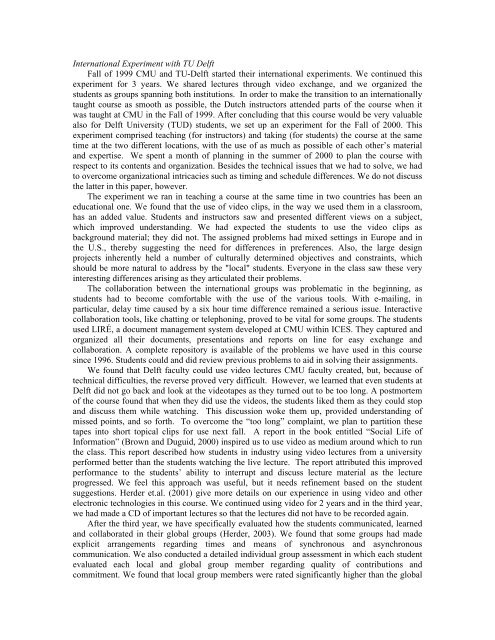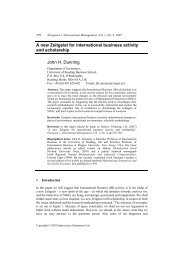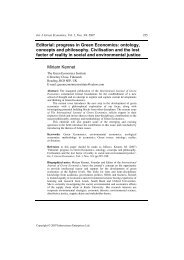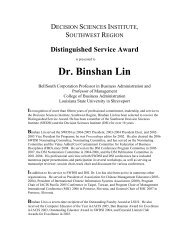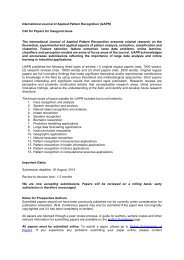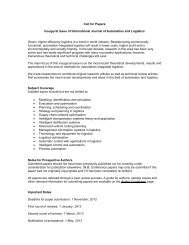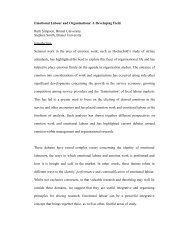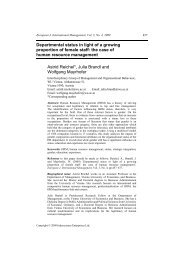in pdf - Inderscience Publishers
in pdf - Inderscience Publishers
in pdf - Inderscience Publishers
- No tags were found...
You also want an ePaper? Increase the reach of your titles
YUMPU automatically turns print PDFs into web optimized ePapers that Google loves.
International Experiment with TU Delft<br />
Fall of 1999 CMU and TU-Delft started their <strong>in</strong>ternational experiments. We cont<strong>in</strong>ued this<br />
experiment for 3 years. We shared lectures through video exchange, and we organized the<br />
students as groups spann<strong>in</strong>g both <strong>in</strong>stitutions. In order to make the transition to an <strong>in</strong>ternationally<br />
taught course as smooth as possible, the Dutch <strong>in</strong>structors attended parts of the course when it<br />
was taught at CMU <strong>in</strong> the Fall of 1999. After conclud<strong>in</strong>g that this course would be very valuable<br />
also for Delft University (TUD) students, we set up an experiment for the Fall of 2000. This<br />
experiment comprised teach<strong>in</strong>g (for <strong>in</strong>structors) and tak<strong>in</strong>g (for students) the course at the same<br />
time at the two different locations, with the use of as much as possible of each other’s material<br />
and expertise. We spent a month of plann<strong>in</strong>g <strong>in</strong> the summer of 2000 to plan the course with<br />
respect to its contents and organization. Besides the technical issues that we had to solve, we had<br />
to overcome organizational <strong>in</strong>tricacies such as tim<strong>in</strong>g and schedule differences. We do not discuss<br />
the latter <strong>in</strong> this paper, however.<br />
The experiment we ran <strong>in</strong> teach<strong>in</strong>g a course at the same time <strong>in</strong> two countries has been an<br />
educational one. We found that the use of video clips, <strong>in</strong> the way we used them <strong>in</strong> a classroom,<br />
has an added value. Students and <strong>in</strong>structors saw and presented different views on a subject,<br />
which improved understand<strong>in</strong>g. We had expected the students to use the video clips as<br />
background material; they did not. The assigned problems had mixed sett<strong>in</strong>gs <strong>in</strong> Europe and <strong>in</strong><br />
the U.S., thereby suggest<strong>in</strong>g the need for differences <strong>in</strong> preferences. Also, the large design<br />
projects <strong>in</strong>herently held a number of culturally determ<strong>in</strong>ed objectives and constra<strong>in</strong>ts, which<br />
should be more natural to address by the "local" students. Everyone <strong>in</strong> the class saw these very<br />
<strong>in</strong>terest<strong>in</strong>g differences aris<strong>in</strong>g as they articulated their problems.<br />
The collaboration between the <strong>in</strong>ternational groups was problematic <strong>in</strong> the beg<strong>in</strong>n<strong>in</strong>g, as<br />
students had to become comfortable with the use of the various tools. With e-mail<strong>in</strong>g, <strong>in</strong><br />
particular, delay time caused by a six hour time difference rema<strong>in</strong>ed a serious issue. Interactive<br />
collaboration tools, like chatt<strong>in</strong>g or telephon<strong>in</strong>g, proved to be vital for some groups. The students<br />
used LIRÉ, a document management system developed at CMU with<strong>in</strong> ICES. They captured and<br />
organized all their documents, presentations and reports on l<strong>in</strong>e for easy exchange and<br />
collaboration. A complete repository is available of the problems we have used <strong>in</strong> this course<br />
s<strong>in</strong>ce 1996. Students could and did review previous problems to aid <strong>in</strong> solv<strong>in</strong>g their assignments.<br />
We found that Delft faculty could use video lectures CMU faculty created, but, because of<br />
technical difficulties, the reverse proved very difficult. However, we learned that even students at<br />
Delft did not go back and look at the videotapes as they turned out to be too long. A postmortem<br />
of the course found that when they did use the videos, the students liked them as they could stop<br />
and discuss them while watch<strong>in</strong>g. This discussion woke them up, provided understand<strong>in</strong>g of<br />
missed po<strong>in</strong>ts, and so forth. To overcome the “too long” compla<strong>in</strong>t, we plan to partition these<br />
tapes <strong>in</strong>to short topical clips for use next fall. A report <strong>in</strong> the book entitled “Social Life of<br />
Information” (Brown and Duguid, 2000) <strong>in</strong>spired us to use video as medium around which to run<br />
the class. This report described how students <strong>in</strong> <strong>in</strong>dustry us<strong>in</strong>g video lectures from a university<br />
performed better than the students watch<strong>in</strong>g the live lecture. The report attributed this improved<br />
performance to the students’ ability to <strong>in</strong>terrupt and discuss lecture material as the lecture<br />
progressed. We feel this approach was useful, but it needs ref<strong>in</strong>ement based on the student<br />
suggestions. Herder et.al. (2001) give more details on our experience <strong>in</strong> us<strong>in</strong>g video and other<br />
electronic technologies <strong>in</strong> this course. We cont<strong>in</strong>ued us<strong>in</strong>g video for 2 years and <strong>in</strong> the third year,<br />
we had made a CD of important lectures so that the lectures did not have to be recorded aga<strong>in</strong>.<br />
After the third year, we have specifically evaluated how the students communicated, learned<br />
and collaborated <strong>in</strong> their global groups (Herder, 2003). We found that some groups had made<br />
explicit arrangements regard<strong>in</strong>g times and means of synchronous and asynchronous<br />
communication. We also conducted a detailed <strong>in</strong>dividual group assessment <strong>in</strong> which each student<br />
evaluated each local and global group member regard<strong>in</strong>g quality of contributions and<br />
commitment. We found that local group members were rated significantly higher than the global


